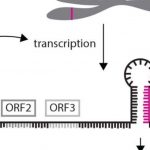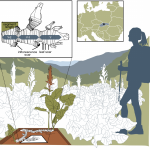Plant Science Research Weekly: August 7, 2020
Review: Potential applications of plant biotechnology against SARS-CoV-2
 For those of you about to start teaching again, here’s a great article to share with your plant science students, showcasing the ways that plant biologists are contributing to the international efforts to develop diagnostic reagents, vaccines, and antiviral drugs to combat the global COVID-19 pandemic. Plants are particularly useful in these efforts as protein production in plants through transient expression systems can be achieved more rapidly than in other cell culture systems. This technology can be used to produce viral proteins for use in vaccines, stimulating immunity in humans. Similarly, antibody proteins produced in plants can be used to detect the presence of the virus for in vitro diagnostics, or injected into patients to help them fight off the virus. Carbohydrate-binding proteins called lectins can be produced in plants and act as effective anti-viral agents that bind to the carbohydrates on the viral surface. Given that COVID-19 is on everyone’s mind, why not use it as a chance to slip in a discussion of plant biotechnology? (Summary by Mary Williams @PlantTeaching) Trends Plant Sci. 10.1016/j.tplants.2020.04.009
For those of you about to start teaching again, here’s a great article to share with your plant science students, showcasing the ways that plant biologists are contributing to the international efforts to develop diagnostic reagents, vaccines, and antiviral drugs to combat the global COVID-19 pandemic. Plants are particularly useful in these efforts as protein production in plants through transient expression systems can be achieved more rapidly than in other cell culture systems. This technology can be used to produce viral proteins for use in vaccines, stimulating immunity in humans. Similarly, antibody proteins produced in plants can be used to detect the presence of the virus for in vitro diagnostics, or injected into patients to help them fight off the virus. Carbohydrate-binding proteins called lectins can be produced in plants and act as effective anti-viral agents that bind to the carbohydrates on the viral surface. Given that COVID-19 is on everyone’s mind, why not use it as a chance to slip in a discussion of plant biotechnology? (Summary by Mary Williams @PlantTeaching) Trends Plant Sci. 10.1016/j.tplants.2020.04.009
Complete microviscosity maps of living plant cells and tissues with a toolbox of targeting mechanoprobes
 Biological processes are ruled by physical as well as chemical forces and properties, but the former are much less well understood and studied. Here, Michels et al. describe a collection of fluorescent probes that provide a quantitative visual readout of microviscocity, reflecting the physical properties of cellular compartments. The core of each probe is a molecular rotor. Photoexcition causes rotation that leads to fluorescence, and the rate of decay of the excited state is determined by the time it takes for the probe to relax to the initial state – in other words, more viscosity or other rotational constraints leads to a longer emission period. The authors developed a set of probes with chemical modifications that target each to the vacuole, cytosol, membrane or cell wall. The decay time is affected differently by the different compositions of each compartment (for example, in membranes it is affected by lipid packing, and in walls by the network mesh size), but within a compartment the probes can detect localized differences in microviscosity. Using these probes, the authors demonstrate differences between cell types and during cell differentiation. As the authors summarize, “These results pave the way to the noninvasive micromechanical mapping of complex tissues.” (Summary by Mary Williams @PlantTeaching) Proc. Natl. Acad. Sci. USA 10.1073/pnas.1921374117
Biological processes are ruled by physical as well as chemical forces and properties, but the former are much less well understood and studied. Here, Michels et al. describe a collection of fluorescent probes that provide a quantitative visual readout of microviscocity, reflecting the physical properties of cellular compartments. The core of each probe is a molecular rotor. Photoexcition causes rotation that leads to fluorescence, and the rate of decay of the excited state is determined by the time it takes for the probe to relax to the initial state – in other words, more viscosity or other rotational constraints leads to a longer emission period. The authors developed a set of probes with chemical modifications that target each to the vacuole, cytosol, membrane or cell wall. The decay time is affected differently by the different compositions of each compartment (for example, in membranes it is affected by lipid packing, and in walls by the network mesh size), but within a compartment the probes can detect localized differences in microviscosity. Using these probes, the authors demonstrate differences between cell types and during cell differentiation. As the authors summarize, “These results pave the way to the noninvasive micromechanical mapping of complex tissues.” (Summary by Mary Williams @PlantTeaching) Proc. Natl. Acad. Sci. USA 10.1073/pnas.1921374117
The key role of terminators on the expression and post-transcriptional gene silencing of transgenes
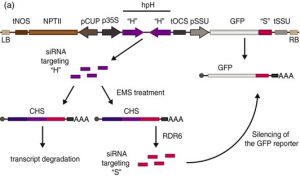 Transgene introduction has been a major tool in modern plant science, but the ability of plants to distinguish ‘self’ from ‘non-self’ can lead to transgene silencing. This mechanism is mediated by the recruitment of RDR6 (an RNA-Dependent RNA polymerases) leading to the production of several siRNAs (small interfering RNAs) targeting the transgenes for silencing. The molecular mechanism behind the susceptibility of transgenes to silencing is still an open question. To address it, Felippes et al. used a GFP reporter that is insensitive to transitive siRNAs silencing to screen EMS mutant lines to identify genes that protect against the formation of secondary siRNAs. In the unmutated plants, GFP expression remains on, but in those that permit silencing the GFP expression is suppressed. The mutant screening identified genes with major roles in transcription termination, revealing the role of terminators in forming secondary siRNAs. Further experiments with showed that a strong terminator with an ability to precisely terminate the transcript will help in decreasing the production of siRNA and maintaining the stability of the transgene. Furthermore, the presence of introns can also help in maintaining the transgene stability, although in some case, position of intron in relation to terminator can lead to formation of siRNAs. This paper demonstrates the importance of the terminator on the expression and post-transcriptional gene silencing of transgenes. (Summary by Sunita Pathak @psunita980) Plant J. 10.1111/tpj.14907
Transgene introduction has been a major tool in modern plant science, but the ability of plants to distinguish ‘self’ from ‘non-self’ can lead to transgene silencing. This mechanism is mediated by the recruitment of RDR6 (an RNA-Dependent RNA polymerases) leading to the production of several siRNAs (small interfering RNAs) targeting the transgenes for silencing. The molecular mechanism behind the susceptibility of transgenes to silencing is still an open question. To address it, Felippes et al. used a GFP reporter that is insensitive to transitive siRNAs silencing to screen EMS mutant lines to identify genes that protect against the formation of secondary siRNAs. In the unmutated plants, GFP expression remains on, but in those that permit silencing the GFP expression is suppressed. The mutant screening identified genes with major roles in transcription termination, revealing the role of terminators in forming secondary siRNAs. Further experiments with showed that a strong terminator with an ability to precisely terminate the transcript will help in decreasing the production of siRNA and maintaining the stability of the transgene. Furthermore, the presence of introns can also help in maintaining the transgene stability, although in some case, position of intron in relation to terminator can lead to formation of siRNAs. This paper demonstrates the importance of the terminator on the expression and post-transcriptional gene silencing of transgenes. (Summary by Sunita Pathak @psunita980) Plant J. 10.1111/tpj.14907
The CDK inhibitor SIAMESE targets both CDKA;1 and CDKB1 complexes to establish endoreplication in trichomes
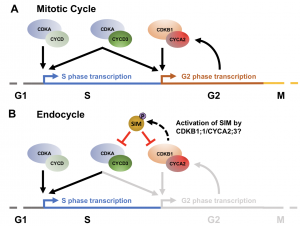 Endoreplication is a process in which DNA doubles without cell division. Trichomes (epidermal hairs) serve as a good system in which to study endoreplication. Cyclin (CYC) and cyclin dependent kinases (CDK) promote cell division and inhibit endoreplication. In plant trichomes, two CDK/CYC complexes, CDKA;1/CYCD3 and CDKB1/CYCA2, promote cell division. CDK inhibitors inactivate CDK/CYC complexes to promote endoreplication. In plants, SIAMESE (SIM) and its related proteins (SMR) act as CDK inhibitors. However, it is not known which of the two above-mentioned CDKs/CYCs are the targets of SIM in vivo. In this paper, Wang et al. identified that SIM acts through both CDKA;1 and CDKB1 using genetic interaction and protein-protein interaction studies. In addition, the authors identified that SIM interacts with CYCA2 but not CYCD3. Thus, this paper corroborates some of the in vitro evidence that SIM acts through both CDKA;1/CYCD3 and CDKB1/CYCA2 complexes to regulate endoreplication in vivo in Arabidopsis trichomes. Summary by (Vijaya Batthula, @Vijaya_Batthula). Plant Physiol. 10.1104/pp.20.00271
Endoreplication is a process in which DNA doubles without cell division. Trichomes (epidermal hairs) serve as a good system in which to study endoreplication. Cyclin (CYC) and cyclin dependent kinases (CDK) promote cell division and inhibit endoreplication. In plant trichomes, two CDK/CYC complexes, CDKA;1/CYCD3 and CDKB1/CYCA2, promote cell division. CDK inhibitors inactivate CDK/CYC complexes to promote endoreplication. In plants, SIAMESE (SIM) and its related proteins (SMR) act as CDK inhibitors. However, it is not known which of the two above-mentioned CDKs/CYCs are the targets of SIM in vivo. In this paper, Wang et al. identified that SIM acts through both CDKA;1 and CDKB1 using genetic interaction and protein-protein interaction studies. In addition, the authors identified that SIM interacts with CYCA2 but not CYCD3. Thus, this paper corroborates some of the in vitro evidence that SIM acts through both CDKA;1/CYCD3 and CDKB1/CYCA2 complexes to regulate endoreplication in vivo in Arabidopsis trichomes. Summary by (Vijaya Batthula, @Vijaya_Batthula). Plant Physiol. 10.1104/pp.20.00271
Antagonistic regulation of the gibberellic acid response during stem growth in rice
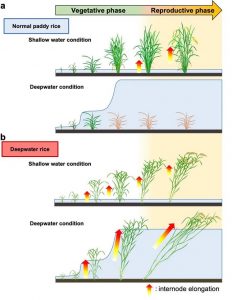 Stem growth determines the final height of graminaceous plants and greatly influences productivity in cultivated species (e.g., short internodes in semi-dwarf rice varieties to increase lodging resistance) and adaptation in wild species (e.g., elongated internodes in tall deepwater rice to help survive flooding). In this article, Nagai and coworkers identified key regulatory factors involved in the initiation of internode elongation in responde to gibberellic acid (GA), and found that genetic variation at the ACCELERATOR and DECELARATOR OF INTERNODE ELONGATION1 (ACE1, DEC1) loci accounts for differences in plant height observed in paddy rice (T65) and deepwater rice (C9285). The deepwater C9285 allele of ACE1 is responsive to GA treatment; its activation in the cell-elongation zone marks internode elongation during the vegetative phase. By contrast, the paddy T65 allele is not functional, due to a 1-bp insertion in the coding sequence. By contrast, both T65 and C9285 DEC1 alleles are functional but they differ in their expression level, likely due to variation in the promoter. Indeed, treatment with GA or deep-water conditions decrease the transcription of DEC1 in C9285, decreasing elongation inhibition, but not in T65. To conclude, genetic diversity at ACE1 and DEC1 has contributed to opposite selection processes: dwarfism selection during domestication and internode elongation selection during environmental adaptation. (Summary by Michela Osnato @michela_osnato) Nature 10.1038/s41586-020-2501-8
Stem growth determines the final height of graminaceous plants and greatly influences productivity in cultivated species (e.g., short internodes in semi-dwarf rice varieties to increase lodging resistance) and adaptation in wild species (e.g., elongated internodes in tall deepwater rice to help survive flooding). In this article, Nagai and coworkers identified key regulatory factors involved in the initiation of internode elongation in responde to gibberellic acid (GA), and found that genetic variation at the ACCELERATOR and DECELARATOR OF INTERNODE ELONGATION1 (ACE1, DEC1) loci accounts for differences in plant height observed in paddy rice (T65) and deepwater rice (C9285). The deepwater C9285 allele of ACE1 is responsive to GA treatment; its activation in the cell-elongation zone marks internode elongation during the vegetative phase. By contrast, the paddy T65 allele is not functional, due to a 1-bp insertion in the coding sequence. By contrast, both T65 and C9285 DEC1 alleles are functional but they differ in their expression level, likely due to variation in the promoter. Indeed, treatment with GA or deep-water conditions decrease the transcription of DEC1 in C9285, decreasing elongation inhibition, but not in T65. To conclude, genetic diversity at ACE1 and DEC1 has contributed to opposite selection processes: dwarfism selection during domestication and internode elongation selection during environmental adaptation. (Summary by Michela Osnato @michela_osnato) Nature 10.1038/s41586-020-2501-8
The Apple miR171i and its target SCL26.1 enhance drought tolerance
 Drought is one of the most important abiotic factors affecting plant growth and development. MicroRNAs are a class of small nuclear RNAs (snRNAs) consisting of 21-24 nucleotides, that play critical roles in many biological processes by regulating target gene expression. Apple is one of the most economically important fruits. It’s yield and quality are decreased due to drought, but the role of snRNAs in drought response are not well characterized. By adopting high-throughput small RNA sequencing and degradome analyses, Wang et al. identified various snRNAs and their targets in drought treatment from the ancestral species of cultivated apple, Malus sieversii, which is greatly tolerance to drought stress. A set of 40 known miRNAs and 8 unidentified snRNAs are differentially expressed during short term drought stress in apple. The authors found that miR171i targets and degrades a transcription factor, SCARECOW-LIKE PROTEIN 26.1 (SCL26.1). Overexpression of miR171i in Arabidopsis renders the plants more sensitive to drought, while miR171i knockout and overexpression of SCL26.1 in apple enhances drought tolerance. The miR171i-SCL26.1 module promotes the expression of various reactive oxygen species (ROS) scavenging enzymes, particularly monodehydroascorbate reductase (MDHAR). Overall, this study provides an insight to improve drought stress in apple through the miR171i-SCL26.1 module by increasing antioxidant enzyme activity in the ascorbic acid cycle. (Summary by Min May Wong @wongminmay) Plant Physiology 10.1104/pp.20.00476
Drought is one of the most important abiotic factors affecting plant growth and development. MicroRNAs are a class of small nuclear RNAs (snRNAs) consisting of 21-24 nucleotides, that play critical roles in many biological processes by regulating target gene expression. Apple is one of the most economically important fruits. It’s yield and quality are decreased due to drought, but the role of snRNAs in drought response are not well characterized. By adopting high-throughput small RNA sequencing and degradome analyses, Wang et al. identified various snRNAs and their targets in drought treatment from the ancestral species of cultivated apple, Malus sieversii, which is greatly tolerance to drought stress. A set of 40 known miRNAs and 8 unidentified snRNAs are differentially expressed during short term drought stress in apple. The authors found that miR171i targets and degrades a transcription factor, SCARECOW-LIKE PROTEIN 26.1 (SCL26.1). Overexpression of miR171i in Arabidopsis renders the plants more sensitive to drought, while miR171i knockout and overexpression of SCL26.1 in apple enhances drought tolerance. The miR171i-SCL26.1 module promotes the expression of various reactive oxygen species (ROS) scavenging enzymes, particularly monodehydroascorbate reductase (MDHAR). Overall, this study provides an insight to improve drought stress in apple through the miR171i-SCL26.1 module by increasing antioxidant enzyme activity in the ascorbic acid cycle. (Summary by Min May Wong @wongminmay) Plant Physiology 10.1104/pp.20.00476
Dynamic regulation of Pep-induced immunity through post-translational control of defense transcript splicing
 In plant immunity, signal transduction is tightly modulated through mechanisms including controlled stoichiometry of key regulators. Dressano et al. identified the novel IMMUNOREGULATORY RNA-BINDING PROTEIN (IRR) as a negative regulator of immunity in both maize and Arabidopsis through a screen of Plant Elicitor Peptide (Pep)-induced protein phosphorylation changes. Knockout irr mutants exhibit broad changes in defense gene expression and splicing patterns such as retained introns (RI), which often cause premature stop codons. The authors focused on splicing of CALCIUM-DEPENDENT PROTEIN KINASE 28 (CPK28), an important negative regulator of immunity. The retained intron form, CPK28-RI, is truncated and does not function properly in immunity. The phosphorylation status of IRR is crucial for its regulatory role; dephosphorylation of IRR following Pep treatment disrupts its interaction with CPK28 transcripts, resulting in accumulation of CPK28-RI and its truncated protein. IRR dephosphorylation and CPK28-RI splicing are transient, which enables greater defense activation that does not persist, to restore negative regulation of immunity. This research demonstrates a new mechanism linking post-translational modification of IRR to post-transcriptional regulation of CPK28, dynamically amplifying Pep signaling capacity and immune output. (Summary by Katy Dunning @PlantMomKaty) Nature Plants 10.1038/s41477-020-0724-1
In plant immunity, signal transduction is tightly modulated through mechanisms including controlled stoichiometry of key regulators. Dressano et al. identified the novel IMMUNOREGULATORY RNA-BINDING PROTEIN (IRR) as a negative regulator of immunity in both maize and Arabidopsis through a screen of Plant Elicitor Peptide (Pep)-induced protein phosphorylation changes. Knockout irr mutants exhibit broad changes in defense gene expression and splicing patterns such as retained introns (RI), which often cause premature stop codons. The authors focused on splicing of CALCIUM-DEPENDENT PROTEIN KINASE 28 (CPK28), an important negative regulator of immunity. The retained intron form, CPK28-RI, is truncated and does not function properly in immunity. The phosphorylation status of IRR is crucial for its regulatory role; dephosphorylation of IRR following Pep treatment disrupts its interaction with CPK28 transcripts, resulting in accumulation of CPK28-RI and its truncated protein. IRR dephosphorylation and CPK28-RI splicing are transient, which enables greater defense activation that does not persist, to restore negative regulation of immunity. This research demonstrates a new mechanism linking post-translational modification of IRR to post-transcriptional regulation of CPK28, dynamically amplifying Pep signaling capacity and immune output. (Summary by Katy Dunning @PlantMomKaty) Nature Plants 10.1038/s41477-020-0724-1
Driving factors of disease spread in natural plant-pollinator communities
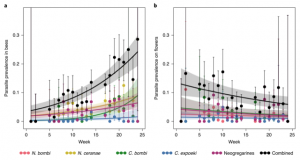 Disease spread within species-rich communities is hard to predict and prevent due to the dynamic transmission of parasites between multiple hosts that change in abundance and composition over time. To better understand the temporal dynamics of bee parasites in communities of plants and pollinators, Graystock and Ng et al. sampled 89 species of flowers and 110 species of bees in the field and screened for five common multi-host parasite species (e.g., trypanosomes, neogregarines or microsporidians) over 26 weeks. The temporal analysis revealed that parasites in bees were the most prevalent late in the year when the bee community is least diverse and dominated by social bees. The authors also found that the prevalence of parasites on flowers was lowest when floral abundance was highest, which may be explained by a smaller number of bee visits per plant. Thus, species turnover and abundance across the bee-flower community are likely important factors influencing the prevalence of parasites. Findings in this study suggests that maintaining high floral numbers and bee biodiversity is a potential strategy to reduce the risk of parasite outbreak in bee-flower communities. (Summary by Tatsuya Nobori @nobolly) Nat. Ecol. Evol. 10.1038/s41559-020-1247-x
Disease spread within species-rich communities is hard to predict and prevent due to the dynamic transmission of parasites between multiple hosts that change in abundance and composition over time. To better understand the temporal dynamics of bee parasites in communities of plants and pollinators, Graystock and Ng et al. sampled 89 species of flowers and 110 species of bees in the field and screened for five common multi-host parasite species (e.g., trypanosomes, neogregarines or microsporidians) over 26 weeks. The temporal analysis revealed that parasites in bees were the most prevalent late in the year when the bee community is least diverse and dominated by social bees. The authors also found that the prevalence of parasites on flowers was lowest when floral abundance was highest, which may be explained by a smaller number of bee visits per plant. Thus, species turnover and abundance across the bee-flower community are likely important factors influencing the prevalence of parasites. Findings in this study suggests that maintaining high floral numbers and bee biodiversity is a potential strategy to reduce the risk of parasite outbreak in bee-flower communities. (Summary by Tatsuya Nobori @nobolly) Nat. Ecol. Evol. 10.1038/s41559-020-1247-x
Alpine plant growth and reproduction dynamics in a warmer world
 Climate warming affects plant performance in warm and dry regions. In cold regions, warming stimulates growth and reproduction, but its effects can vary depending on location and species. Whether herbaceous plants can adapt to increasing temperatures is unclear and a matter of concern. In this study Dolezal et al. investigated the effects of climate warming on different Slovakian populations of the herbaceous plant Rumex alpinus. These plants grow along alpine, subalpine and montane regions in Europe and are consider a good model because they retain past environmental information in their roots and rhizomes, via radial growth rings and annual growth increments respectively. Dolezal et al. tracked environmental influence on plant growth and fitness over 40 years and found that R. alpinus performance was enhanced in warmer climates. Growth of plants in alpine and subalpine regions increase in summer twice as much as 40 years ago and they also produce longer annual rhizomes. In montane regions plant growth increased in spring season. However, such growth and fitness increments appeared to be water-limited, as both growth and flowering were correlated with previous precipitation. Together, these results show that R. alpinus responds rapidly to climate variation and that, while warming temperatures enhanced plant performance, this depends on rain fall which can become limiting as the climate warms. Such observations show a complex response of alpine populations to climate warming and its vulnerability and sensitivity to water shortage. (Summary by Daniela Ramos @DanielaR_cruz) New Phytol. 10.1111/nph.16790
Climate warming affects plant performance in warm and dry regions. In cold regions, warming stimulates growth and reproduction, but its effects can vary depending on location and species. Whether herbaceous plants can adapt to increasing temperatures is unclear and a matter of concern. In this study Dolezal et al. investigated the effects of climate warming on different Slovakian populations of the herbaceous plant Rumex alpinus. These plants grow along alpine, subalpine and montane regions in Europe and are consider a good model because they retain past environmental information in their roots and rhizomes, via radial growth rings and annual growth increments respectively. Dolezal et al. tracked environmental influence on plant growth and fitness over 40 years and found that R. alpinus performance was enhanced in warmer climates. Growth of plants in alpine and subalpine regions increase in summer twice as much as 40 years ago and they also produce longer annual rhizomes. In montane regions plant growth increased in spring season. However, such growth and fitness increments appeared to be water-limited, as both growth and flowering were correlated with previous precipitation. Together, these results show that R. alpinus responds rapidly to climate variation and that, while warming temperatures enhanced plant performance, this depends on rain fall which can become limiting as the climate warms. Such observations show a complex response of alpine populations to climate warming and its vulnerability and sensitivity to water shortage. (Summary by Daniela Ramos @DanielaR_cruz) New Phytol. 10.1111/nph.16790


